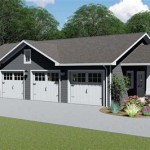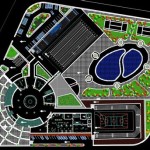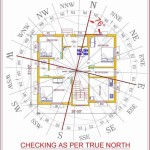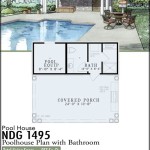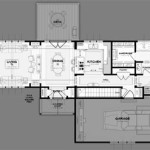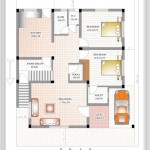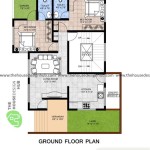East Face House Plan According To Vastu
Vastu Shastra, the ancient Indian science of architecture and design, emphasizes the harmonization of living spaces with natural energies. It posits that aligning a dwelling with cardinal directions and incorporating specific layouts can significantly influence the well-being, prosperity, and overall happiness of its occupants. An east-facing house, in particular, holds considerable significance in Vastu Shastra, as it welcomes the rising sun, considered a powerful source of positive energy and vitality.
Designing an east-facing house according to Vastu principles necessitates careful consideration of various factors, including the placement of the main entrance, rooms, kitchen, and other essential elements. Adhering to these guidelines can create a living environment that promotes health, wealth, and harmonious relationships. This article provides a comprehensive overview of key Vastu principles applicable to east-facing house plans, offering insights into optimizing the layout and orientation for maximum benefit.
The principles outlined are intended as guidelines and might require adjustments based on the specific site conditions and individual requirements. Consulting with a qualified Vastu expert is recommended for personalized advice and tailored solutions.
Significance of the East Direction in Vastu
In Vastu Shastra, the east direction is associated with the rising sun, the source of light, energy, and new beginnings. It is believed that allowing the first rays of sunlight to enter the house promotes positive energy flow, bringing vitality and prosperity. The east is also considered the direction of Lord Indra, the king of gods, symbolizing power and authority. Therefore, an east-facing house, when designed according to Vastu principles, is believed to attract good fortune and success.
The eastern sector of a property is considered auspicious for activities that benefit from the morning sun, such as studying, meditation, and exercising. Open spaces like balconies and gardens in the east can enhance the positive energy within the house. Conversely, blocking the eastern side with large structures or obstructions can impede the flow of beneficial energies and potentially lead to negative consequences.
Key Vastu Principles for East-Facing Houses
Designing an east-facing house according to Vastu involves several key considerations, focusing on the optimal placement of various elements to harness the energy of the rising sun. These principles encompass the location of the main entrance, rooms, kitchen, and other vital areas within the house.
Entrance Location: The main entrance is paramount in Vastu Shastra. For an east-facing house, the entrance should ideally be located in the northeast or east quadrant. Vastu divides each direction into segments or 'padas,' and certain padas are considered more auspicious than others. Precise placement within these auspicious padas is crucial. Avoid locating the main entrance in the southeast, as this is generally considered inauspicious. The entrance door should be well-lit, clean, and aesthetically pleasing, symbolizing a welcoming and positive entry point. A small, well-maintained garden near the entrance can further enhance the positive energy flow.
Living Room Placement: The living room, as the primary gathering space, should also be strategically located. In an east-facing house, the ideal location for the living room is in the northeast or east sector. This allows the space to receive ample morning sunlight, creating a bright and welcoming atmosphere. Furniture should be arranged in a manner that promotes comfortable conversation and allows for easy movement. Avoid cluttering the living room, as this can impede the flow of energy. Keeping the northeast corner of the living room open and uncluttered is especially beneficial.
Bedroom Placement: The master bedroom should ideally be located in the southwest corner of the house, as this area is associated with stability and grounding. For other bedrooms, the northwest or south sectors are suitable options. Avoid locating bedrooms in the northeast corner, as this area is considered sacred and should be kept free from heavy furniture or activities. The bed should be positioned so that the head faces south or west, promoting restful sleep. Avoid placing the bed directly in line with the door, as this can disrupt energy flow. Using calming colors and natural materials in the bedroom can enhance the sense of peace and relaxation.
Kitchen Placement: The kitchen is a vital space representing nourishment and well-being. In an east-facing house, the southeast corner is the most preferred location for the kitchen, governed by the fire element. The cook should ideally face east while cooking, allowing them to receive the beneficial rays of the morning sun. If the southeast isn't feasible, the northwest corner can be considered as an alternative. Avoid locating the kitchen in the northeast corner, as this can disrupt the energy flow and potentially lead to health issues. Keep the kitchen clean and organized, ensuring that the stove and sink are not placed adjacent to each other, as this represents a conflict between fire and water elements. Proper ventilation is also crucial to remove smoke and odors.
Bathroom and Toilet Placement: Bathrooms and toilets are associated with the elimination of waste and are best located in the northwest or west sectors of the house. Avoid placing them in the northeast, east, or southeast corners, as these are considered sacred and should be kept free from negative influences. Ensure proper ventilation in the bathrooms to prevent the accumulation of stagnant energy. Keep the bathroom clean and well-maintained to prevent negative energy from accumulating. Avoid placing the toilet directly opposite the main entrance or any other important room, as this can disrupt the energy flow.
Staircase Placement: Staircases represent upward movement and progress. In an east-facing house, the ideal location for the staircase is in the south, west, or southwest sectors. Avoid placing the staircase in the northeast corner, as this can impede financial growth and create obstacles. The staircase should be constructed in a clockwise direction, symbolizing upward progression. Ensure that the staircase is well-lit and free from clutter. Avoid placing sharp objects or disturbing elements near the staircase.
Open Spaces and Balconies: Open spaces and balconies are essential for allowing natural light and air to enter the house. In an east-facing house, the east and north sides should have ample open spaces. This allows the beneficial rays of the morning sun to penetrate the house, promoting positive energy flow. Balconies and verandas in the east and north are ideal for relaxing and enjoying the outdoors. Avoid blocking the eastern side with tall structures or obstructions, as this can impede the flow of positive energy. A small garden or lawn in the east can further enhance the positive energy within the house.
Remedies for Vastu Defects in East-Facing Houses
Even with careful planning, some Vastu defects might still exist in an east-facing house. These defects can potentially lead to negative consequences, but can be mitigated through Vastu remedies. These remedies often involve subtle adjustments to the layout or the introduction of specific objects to balance the energy flow.
Addressing Entrance Defects: If the main entrance is located in an inauspicious pada, certain remedies can be employed. Placing a Swastika symbol or an image of Lord Ganesha above the entrance can deflect negative energy. Using auspicious colors, such as light yellow or cream, on the entrance door can also enhance positive energy. Placing a doormat at the entrance can help to filter out negative energy entering the house.
Correcting Kitchen Imbalances: If the kitchen is located in the northeast corner, which is generally considered inauspicious, several remedies can be implemented. Placing a Vastu pyramid in the northeast corner can help to neutralize the negative energy. Burning camphor in the kitchen on a regular basis can also purify the air and create a more positive atmosphere. Using earth tones in the kitchen can help to balance the energy. Avoid storing heavy objects in the northeast corner of the kitchen.
Mitigating Bathroom Issues: If the bathroom is located in an inauspicious sector, such as the northeast, certain remedies can be employed. Placing a bowl of sea salt in the bathroom can absorb negative energy. Keeping the bathroom door closed when not in use can also prevent negative energy from spreading throughout the house. Adding a small plant to the bathroom can help to purify the air and create a more balanced atmosphere. Using light colors and natural materials in the bathroom can also enhance positive energy.
Utilizing Crystals and Colors for Energy Enhancement: Colors play a significant role in Vastu Shastra, and using the right colors can enhance the positive energy flow within an east-facing house. Light yellow, cream, and green are considered auspicious colors for the east direction. These colors can be used on walls, furniture, and furnishings. Crystals, such as amethyst and clear quartz, can also be used to enhance the energy flow and promote harmony. Placing these crystals in strategic locations within the house can help to balance the energy and create a more positive atmosphere.
Regular Cleansing and Decluttering: Regularly cleansing and decluttering the house is crucial for maintaining a positive energy flow. This involves removing unnecessary items, cleaning the floors and surfaces, and opening the windows to allow fresh air and sunlight to enter. Clutter can block the flow of energy and create stagnation, leading to negative consequences. A clean and organized house promotes a sense of peace and harmony, allowing positive energy to flow freely.
The application of Vastu principles to east-facing houses aims to create a living environment that promotes health, wealth, and happiness. Understanding the significance of the east direction, the optimal placement of elements, and effective remedies can contribute to a harmonious and prosperous living experience. While these guidelines offer a valuable framework, seeking consultation with a knowledgeable Vastu consultant is essential for personalized recommendations tailored to specific circumstances.

30x40 East Facing House Plan

Best 4 East Facing House Vastu Plan For A Peaceful Life Namma Family

East Facing House Plan Vastu For

Vastu House Plans For East Facing
26 X 33 East Facing 4bhk House Plan According To Vastu

East Facing House Vastu Plan Tips And Things To Avoid

East Facing House Vastu Plan Best Tips For Homes
East Facing House Plan As Per Vastu Shastra Civiconcepts

Best 4 East Facing House Vastu Plan For A Peaceful Life Namma Family

East Facing Vaastu Home Plan Subhavaastu Com

